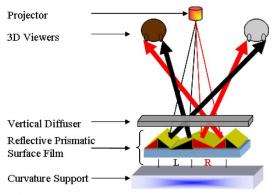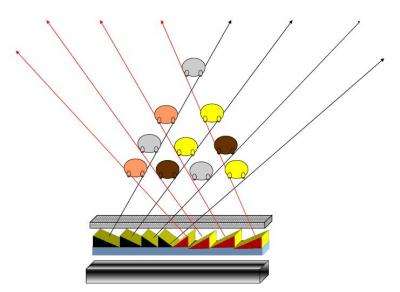March 23, 2010 feature
Prism-patterned screen brings paradigm shift to 3D displays

(PhysOrg.com) -- A team of engineers from Taiwan seems to have overcome one of the most persistent challenges of 3D display technology, which could enable them to produce a cinematic 3D display with superior quality compared to most current systems. Their proposed design combines a prism-patterned projection screen with advanced projection technology to achieve both high optical efficiency and low image crosstalk -- two properties that have been considered mutually exclusive until now.
The researchers, led by Wallen Mphepö from National Chiao Tung University in Hsinchu, Taiwan, and Chalmers University of Technology in Göteborg, Sweden, have published their proposed 3D display design in a recent issue of IEEE's Journal of Display Technology.
The new display uses a prism-patterned 3D screen, a technology which has previously been explored to varying degrees of success. In this system, the prism’s angular surfaces reflect light at two different angles, which are received by a viewer’s left and right eyes, creating a sense of depth through parallax. The prism screen can display 3D images to multiple viewers, as long as they are located within a specific distance range from the screen. The system is also autostereoscopic, meaning viewers do not need glasses to see the 3D effects.
The key to prism-based 3D displays is that the prism screen must effectively separate the left and right image pixels. To achieve this pixel separation, the researchers worked on defining the prism angles as well as the curvature of the entire screen, which is necessary in order to keep the rays within the viewing zone. To derive the curvature’s coordinates, the researchers used an iterative process, with each new point on the curved surface computed based on the previous points’ locations.
The initial results of their simulations showed a large amount of crosstalk between left and right viewing zones, meaning that the right eye could see some residue of the image intended for the left eye, and vice versa. In order to minimize the crosstalk, the researchers reconfigured the prism angles to sharpen the reflected rays’ separation. In addition, they slightly increased the inter-ocular separation (the distance between a viewer’s eyes) from 65 to 70 mm, and moved the viewing location to 1.15 m, 50 mm closer to the screen. These measures reduced the amount of overlap between left and right pixels, virtually eliminating the crosstalk.
However, as the engineers note, it’s not the 0% crosstalk that makes the 3D display innovative, but rather the fact that the display also operates at 90% optical efficiency. As Mphepö explained, previous technologies have always assumed that image crosstalk is inversely proportional to optical efficiency.
“In our design you simultaneously get both the desirable high optical efficiency and desirable low or zero crosstalk,” Mphepö told PhysOrg.com. “This bucks the trend and changes the way standard prevailing autostereoscopic 3D display design assumptions that have been in effect up to this point are to be viewed. In short, they no longer apply.”
For instance, as Mphepö explained, a typical autostereoscopic 3D display might use a parallax barrier - a layer of opaque material with slits that is placed in front of the screen, allowing each eye to see a different set of pixels. If the slits are wide, more light can pass through, which increases the optical efficiency. However, wide slits allow more image crosstalk, since each eye sees more light that is intended only for the other eye. On the other hand, making the slits narrower can reduce image crosstalk, but also blocks most of the light, reducing optical efficiency. Thus there is an inherent tradeoff between optical efficiency and crosstalk in such a design.
To overcome this problem, the new system replaces the parallax barrier with fine-tuned prisms that, as Mphepö explained, reflect light to create a “sweet spot” with high optical efficiency and virtually no crosstalk.

“For our design we made sure that most of the light that comes from the projector and is incident onto our screen is reflected back to the viewers' eyes with no barrier blocking it, raising the overall optical efficiency of the system,” Mphepö explained. “By designing the prisms to reflect the incident light from the projector to specific pre-computed left and right eye locations at the viewing distances, we obtain a sweet spot where there is maximum separation of left and right pixels. At these locations the left and right pixels don't mix, thus giving us an area where there is zero crosstalk even though no barrier is actually between the viewer and the screen, in contrast to the parallax barrier autostereoscopic 3D display.”
Although the 3D viewing zone is currently somewhat small, the design has another important advantage, in that it can be configured to provide several 3D viewing zones without drastically reducing the image resolution. This ability contrasts with other autostereoscopic 3D displays, such as those that use a parallax barrier and those that are based on a lenticular lens, which is what most of the major manufacturers are using today. In both designs, the method of increasing the number of viewers involves dividing up the pixels among viewers, which decreases each viewer’s image resolution - especially for a large number of viewers.
As Mphepö explains, in the prism-based design, the resolution of each individual viewer is reduced by at most only half of the projector's original resolution, no matter how many viewers are added. Instead of dividing up the pixels, the system increases the number of prisms per pixel to accommodate more viewers. In this way, using only 11 prisms per incident projector pixel, the system can accommodate 100 simultaneous autostereoscopic 3D viewers.
“The fabrication process is orders of magnitude simpler, while the number of views that can be generated is much higher and makes cinema autostereoscopic systems more feasible,” Mphepö said. He also added that part of the inspiration for the design came from bouncing off ideas with Professor Michael Bove, Jr., at MIT Media Labs, who is the co-director of The Center for Future Storytelling.
The design still needs work in some areas, such as optimizing the system for an inter-ocular distance of 65 mm, which is considered the ideal distance for most viewers. The researchers also plan to increase the stability and size of the 3D viewing zones to allow for more head movement.
“There are plans to fabricate a prototype of this version of the system and also the second generation version of the system,” Mphepö said. “We are currently looking for companies to collaborate with in realizing some aspects of the system apart from actually manufacturing it at some point down the road.”
More information: Wallen Mphepö, Yi-Pai Huang, Per Rudquist, and Han-Ping Shieh. “An Autostereoscopic 3D Display System Based on Prism Patterned Projection System.” Journal of Display Technology, Vol. 6, No. 3, March 2010. Doi:10.1109/JDT.2009.2034759
Copyright 2010 PhysOrg.com.
All rights reserved. This material may not be published, broadcast, rewritten or redistributed in whole or part without the express written permission of PhysOrg.com.

















